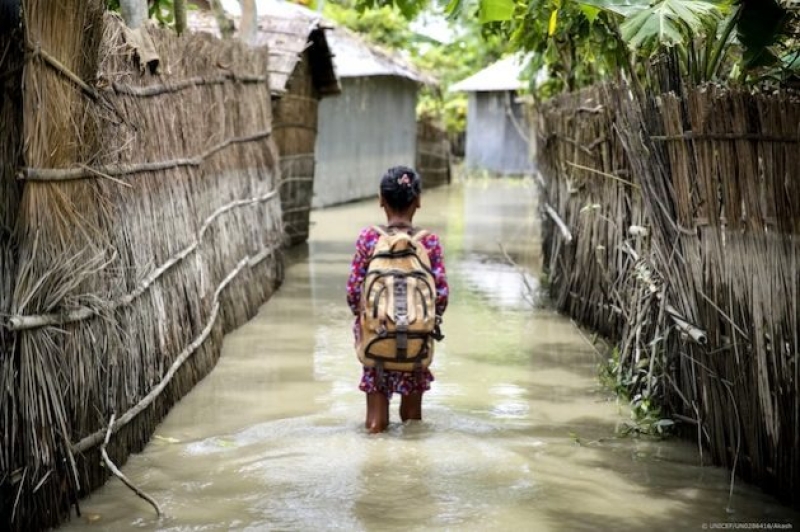- No need to be kind to election disruptors: EC to law enforcers |
- No Media Faced Arson Attacks in 53 Years: Mahfuz Anam |
- Janaza of six Bangladeshi peacekeepers held at Dhaka Cantonment |
- Bangladesh stock market loses Tk 10,500cr in a week |
- Dhaka’s air turns ‘very unhealthy’ on Sunday morning |
Define Financial Path to Education for Climate-Hit Children
COP29 Negotiators Urged

A child wades through water on her way to school in Kurigram district, northern Bangladesh, during floods in August 2016. Credit- UNICEF
By Joyce Chimbi
BAKU, Nov 15 2024 (IPS) - Directly destroying schools and learning materials, climate shocks are increasingly taking away the right to education. A staggering 400 million students globally experienced school closures from extreme weather since 2022. As COP29 negotiations deepen, defining a sustainable financial path to learning for vulnerable children, particularly those caught up in crises and conflict, is critical and urgent.
Concerns are rife that as weather events significantly disrupt continuous learning, opportunities for lifelong learning and earning opportunities will shrink as affected children might never find their way back into the education system. Education Cannot Wait (ECW), the first global fund dedicated to education in emergencies, says COP29 is an unmissable opportunity to chart a financial path to education for climate-affected children.
“Unfortunately, less than 1 percent of all climate-related finance at the moment is going towards education. We have a mandate to elevate the profile of education in emergencies and protracted crises in the COP29 dialogue, as it’s critical that this aspect of financing is strongly amplified. The prevailing lack of financing and climate-related interventions designed for education in emergencies and protracted crises will only derail climate action,” Graham Lang, ECW’s Deputy Director, told IPS.
A one-time investment of around USD 18 per child can mitigate the impact from climate shocks and better safeguard the children from the climate carnage. Lang said it is urgent that climate funds expedite and simplify their approval and disbursement processes to increase funding for adaptation and mitigation projects focusing on sectors that enhance resilience and co-benefits for vulnerable communities, such as education, especially in humanitarian settings.
The nexus between education and climate is undeniable. Extreme weather events are hitting education the hardest in low-income countries, with 18 school days lost annually on average, compared to 2.4 days in wealthier nations. The magnitude of the climate crisis is such that a 10-year-old in 2024 will experience three times more floods, five times more droughts, and 36 times more heatwaves over their lifetime compared to a 10-year-old in 1970.
Dianah Nelson, ECW’s Chief of Education, spoke to IPS about how underinvesting in education creates a knowledge gap in green skills and that this is a missed opportunity in the context of using education to accelerate the efficient and effective implementation of climate action. And raise a generation of young learners on the frontlines of climate action.
While children and young people are the most impacted by climate change, they are also enthusiastic about engaging in climate action. Still, existing education systems are not equipped to adequately facilitate access to knowledge, value, attitudes towards a change in behavior, and innovations required to accelerate sustainable climate action. Financing will raise education to meet the climate challenge.
The demand for green skills—the knowledge, abilities, values, and attitudes needed to live in, develop, and support a sustainable and resource-efficient society—is already outpacing supply in many low- and middle-income countries, with research showing that nearly 73 percent of young people across eight countries mistakenly believe that they cannot get a green job without Science, Technology, Engineering, and Math (STEM) skills. Meanwhile, green skills are being demanded at nearly all skill levels and sectors across low- and middle-income countries.
Nelson stressed that “education is a unique sector that can help reach not just schools, teachers, and learners but surrounding communities, and this helps reduce the cost of climate action while improving the attainment of positive and life-transformative outcomes. At COP29, we have a real opportunity to make a difference by financing education to reach all children, everywhere.”
ECW is advocating for simpler funding and fund disbursement processes as they are the only lifelong for climate-impacted children in vulnerable, high-risk countries. Meanwhile, Lang calls for a comprehensive, research-backed loss and damage finance gap report to give an accurate account of the current education financial needs and gaps.
Nelson emphasized that climate-related financing for education helps reach affected children while also averting additional challenges that come with school closures. Stressing that “schools can be utilized as essential climate action hubs for information sharing on early warning systems. Research is telling us that when children are engaged and involved in climate action, they have the highest impact on their families and communities.
Within this context, Lang says extending financial support would help build climate-resilient education infrastructure while also training learners to be positive agents of change. On the most desirable COP29 education outcome, he says the COP29 Baku deal must break the historical silence that shrouds education in climate settings and more in critical COP negotiations.
“We want the conference declaration document to explicitly reference education and even go a step further to refer to education in humanitarian settings. This would give the neglected sector a much-needed boost and help reach learners disproportionately affected by climate and left furthest behind the education system with an opportunity to shape their futures,” Lang emphasized.
IPS UN Bureau Report

